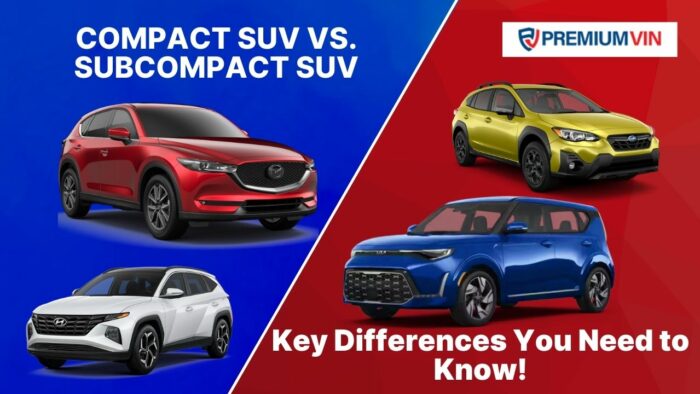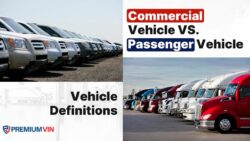Here is the significant difference between a compact SUV and a subcompact SUV: In essence, the main distinction is slightly in the dimension, capacity and even traits of each of them.
Regarding the advantages of compact SUVs, these are a class between subcompact and midsized SUVs. They have more space inside, offering till 5 persons to fit in and leg- and head room is increased as well.
This together with large cabin space makes them suitable for family use or any user who requires extra space for baggage, foods or any materials that may be needed.
Commonly they have better engines, therefore competence like performance and hauling capacity such as towing.
On the same note, compact SUVs have extra features of technologies, safety and luxury features thus the prices have to be slightly higher than those of subcompact SUVs.
On the other hand, subcompact SUVs are indeed, SUVs, but they are slightly smaller and are easier to maneuver especially that they are categorized more for city and country driving and tight parking space.
Often it has restricted interior accommodation, and also the boot space, those cars which are manufactured for people who have little storage needs. The same limited trims when fitted with smaller engines as the upper delivers low power but enormous efficiency.
They may not offer as many niceties as compact SUVs do but there are all the packages in terms of infotainment and safety that may entice people in this class.
That is, compact SUVs are larger, furnish more room, deliver superior power and offers than the subcompact SUVs, yet subcompact SUVs are in smaller sizes, cheaper and can efficiently negotiate the small streets.
Compact vs Subcompact
The following is a tabular comparison of a compact and a subcompact.
| Features | Compact | Sub-compact |
| Size and Space | These SUVs offer a spacious and comfortable interior, perfect for families or those who frequently transport passengers and cargo. Ample legroom, headroom, and a generous cargo area make them ideal for road trips and hauling gear. However, their larger size can make navigating tight city streets and parking lots a challenge. | Subcompacts prioritize maneuverability and agility. Their smaller footprint makes them a breeze to zip through traffic and squeeze into tight parking spots. However, this comes at the cost of interior space. While suitable for small families or individuals who travel light, subcompacts might feel cramped for passengers and cargo on longer journeys. |
| Fuel Efficiency | Due to their larger size and weight, compact SUVs typically have lower fuel efficiency compared to subcompacts. This translates to higher gas costs, especially for frequent city drivers. However, advancements in engine technology have narrowed the gap, and some compact SUVs offer surprisingly good gas mileage. | Fuel efficiency is a major selling point for subcompacts. Their smaller size and lighter weight contribute to better gas mileage, making them a budget-friendly option for city driving and commuting. |
| Price | Generally, compact SUVs carry a higher price tag than subcompacts. This reflects the larger interior space, more powerful engines (often translating to better towing capacity), and a wider range of standard features. However, you might find good deals on specific models, especially pre-owned ones. | Subcompacts are generally more affordable than their compact counterparts. This makes them an attractive option for budget-conscious buyers. However, keep in mind that lower costs might mean fewer standard features and potentially lower-quality materials. |
| Performance | Generally, compact SUVs carry a higher price tag than subcompacts. This reflects the larger interior space, more powerful engines (often translating to better towing capacity), and a wider range of standard features. However, you might find good deals on specific models, especially pre-owned ones. | Subcompacts prioritize agility and maneuverability. Their smaller size and lighter weight make them perfect for navigating city streets and tight corners. However, they typically have lower ground clearance and less powerful engines, limiting their off-road capabilities and towing capacity. |
| Features | Compact SUVs are often packed with features, ranging from advanced safety systems like blind-spot monitoring and lane departure warning to luxurious amenities like heated seats and sunroofs. They also tend to have more sophisticated infotainment systems with larger touchscreens and better sound quality. | Subcompacts prioritize agility and maneuverability. Their smaller size and lighter weight make them perfect for navigating city streets and tight corners. However, they typically have lower ground clearance and less powerful engines, limiting their off-road capabilities and towing capacity. |
DID YOU KNOW?
Statista reports that: “SUVs accounted for 43.2% of the worldwide market revenue in 2022. This is a 0.3% growth compared to market share in 2018. The highest revenue share of SUV sales in 2022 was generated in Canada (56.2%) and South Africa (53.4%). The best-performing maker in the SUVs segment in 2022 was Toyota (revenue of US$68.8 billion), followed by Ford (US$ 62.6 billion) and Honda (US$51.7 billion).”
Read Also: How Many Miles Should a New Car Have?
Examples of Compact SUVs
The following are a few examples of prominent compact SUVs
- Mazda CX-5
- Hyundai Tucson
- Subaru Forester
- Ford Bronco Sport
- Kia Sportage
- Honda CR-V
- Mazda CX-50
- Toyota RAV4
While the following are sub-compact SUVs
- Kia Soul
- Kia Seltos
- Mazda CX-30
- Hyundai Kona
- Subaru Crosstrek
- Volkswagen Taos
- Buick Envista
- Honda HR-V
Popularity and Market Demand
A recent study by GrandViewResearch showed the worldwide market for small SUVs was worth $551.2 billion in 2021. It’s expected to grow a bit, at a rate of 0.33% yearly from 2022 to 2028. More people liking SUVs is a big reason for this increase in the small SUV market.
Studies from around the world show that small SUVs are becoming more popular than bigger SUVs.
A main reason for loving small SUVs is they cost less. Many people find driving smaller SUVs easier than driving bigger ones. The lower price and ease of driving are the main reasons why more people like them.
READ ALSO: Expert Guide on Yamaha VIN decoder
Benefits of a compact SUV
Here are some benefits of a compact SUV:
- Spaciousness: Offers more cargo space and legroom than subcompacts, making them ideal for families.
- Comfort: Provides comfortable rear seats with ample legroom for passengers.
- Versatility: More versatile than subcompacts, accommodating both passengers and cargo needs.
- Safety: Often includes the option for all-wheel drive, enhancing control in various weather conditions (may not be available on all subcompacts).
- Fuel efficiency: Maintains good fuel economy despite being larger than subcompacts.
- Visibility: Offers a higher seating position for a better road view, just like subcompacts.
Benefits of a Sub-Compact SUV
Interestingly, the subcompact combines the features of a small vehicle with those of a larger SUV. Using a subcompact SUV can provide the following benefits:
Seating Position: You can have a relatively larger view of the road with this type of vehicle.
Fuel Efficiency: They tend to be more fuel-efficient than midsized or compact SUVs.
Handling: Users have reported finding the subcompact SUV easier to handle and maneuver than larger vehicles.
Used SUV Sales: Market Overview
Here’s general statistical data for Q1 2024 based on the information found on Coxautonic
| Metric | Data |
| Total salles | 5,954,075 |
| March to April Change | -12.7% decrease |
Sales increased from February to March by 18.5% and then decreased from March to April
Compared to the previous year’s data, there has been an increase in the sales of used vehicles, so SUVs are surely not left out.
So many people opt for used vehicles because they are usually economical, especially if they have a clean title.
It takes more than a mechanical and physical inspection to know if a used vehicle is safe for use hence we strongly recommend that you run a VIN check. A VIN check will help you determine if a car or SUV has some negative historical trait that ordinarily goes undetected by a mechanical check, such as a rolled-back odometer, loan/lien issues, number of previous owners, theft records, title information, etc.







